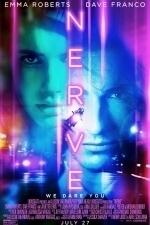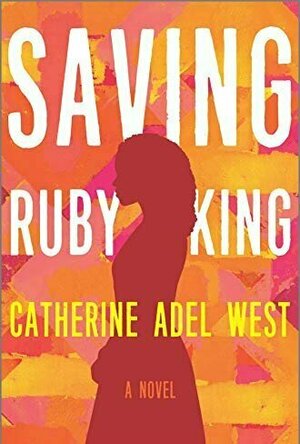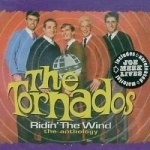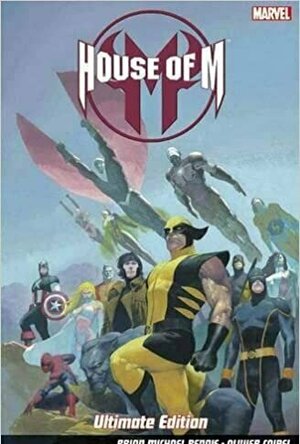Gareth von Kallenbach (980 KP) rated Nerve (2016) in Movies
Aug 6, 2019
Nerve feels like its two movies in one. For the first two acts, Nerve is a young adult/teen film where we follow Vee (Emma Roberts) as she breaks free from her unassertive personality that has her in the background among her friends and afraid to tell her family where she wants to go to college. She is a good kid, but too timid to go after anything she really wants. Instead through the challenges of the game Nerve, she gains confidence in herself as she becomes involved with another Nerve player Ian (Dave Franco). Together, along with a fast paced uplifting soundtrack, we are taken on a fun and entertaining ride where you cannot help but care about these two and wonder what you would do in their situation.
Roberts and Franco are likable in their roles and they lead a stellar young cast who are all realistic in their youthful portrayal. Not too surprising because they are actually young actors, but it is important to note that the cast feels “real,” which helps sell the believability that a game like “Nerve” could actually exist in our world. Especially in a world where we are glued to our phones, tablets and computers in order to be the “star of our own lives” through the instant gratification of social media. Along with the recent emergence of the popularity of augmented reality games like Pokémon Go, it is conceivable that a game like Nerve could exist in our near future.
But this is where the film starts to fall apart. In the third act, the film hastily transitions into a social commentary of the anonymity of the internet, mob think and what we are willing to share online. While I understand this is a message that seem appropriate a story like this, that message would have been better served in a sinister film like the aforementioned, 13 Sins, and not in a movie which up to that point, felt that it was headed towards being an inspiring and uplifting film. It doesn’t help that the resolution of that social commentary was comical in its execution that completely pulls you out of the film. It was an unnecessary turn that wanted us to focus on the game Nerve rather than the characters the story made us care about. It’s a shame really because up until that point, the film Nerve was fun, enjoyable and inspiring, only to fall apart for no real reason other than to make a weak attempt at being something more than a teen movie.
I am sure the young adult/teenage audience this film is marketed towards will enjoy Nerve, but this film is really more of a rental or at most, a matinee.
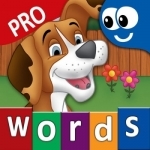
First Words for Kids and Toddlers Professional: Preschool learning reading through letter recognition and spelling
Games and Education
App
Welcome to "First Words for Kids Professional", the Professional edition of the ultimate first words...

Dexteria Jr. - Fine Motor Skill Development
Education and Medical
App
(Ed. note: Be sure to also check out the new award-winning app Dexteria VMI.) "I am going to start...

Die große Wörterfabrik
Book and Games
App
NEW: Now for iPad AND iPhone - You can now install this app on both your iPad and on your iPhone. ...

Grand Designs Australia Magazine – Inspiring you to create your dream home
Lifestyle and Magazines & Newspapers
App
Grand Designs Australia DIGITAL Magazine. “Inspiring you to create your dream home” At Grand...
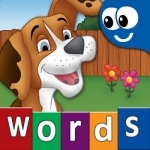
First Words for Kids with Phonics and Letter Names
Games and Education
App
Welcome to "First Words for Kids", the ultimate first words educational app that uses Synthetic...
Kristy H (1252 KP) rated Saving Ruby King in Books
Jun 18, 2020
"I'm stitched together by the lies I tell myself and the lies people want to believe about me." ~Alice
I found this excellent and timely book to be incredibly well-written, with a power and tenderness to it that goes far behind your typical debut novel (I had to double check that this was actually West's first novel, I was so impressed).
West tells her story from a variety of points of view--Ruby; her late mother, Alice; her father, Lebanon; her best friend, Layla; Layla's father, a pastor; and more. We even hear from a central figure in all of these characters' lives--their church, via its omnipresent voice. The plot spans generations, with West giving a nuanced look at each of her complex characters. She does an amazing job of showing the power of family, for both good and bad. How choices can affect generations: one person's bad decisions can pass poison on, with children reliving dysfunction and sins.
"How can there be a me without her?" ~Ruby
No one is simply good or bad here, though Lebanon is not an easy-to-like man. Abused and neglected by his own parent, Sara, we see how Sara's neglect has turned Lebanon hard. But West is such a good writer that Lebanon is not a one-dimensional bad guy, as much as you want to hate him. I was incredibly impressed at how she could create sympathy for so many of her players, even when they did despicable things.
"Without Sara, who do I blame for...being me? Are children supposed to forgive their parents for the horrible things they've done?" ~Lebanon
This novel does an impressive job at delving into racism, domestic abuse, and sexual assault and trauma. The city of Chicago appears as its own character, springing to life via West's lovely prose. She expertly shows the difficulties black people face on the south side (and in general). I read this book during George Floyd's murder and found myself highlighting passages about police brutality that just hit me right in the gut. It's very powerful.
West's book features a variety of characters--they can be hard to keep track of at first, and I was glad to have the family tree in the beginning of the book. A few times the plot felt repetitious and the middle dragged a bit, but it picked up in the second half. There's a surprising amount of twists and turns. Overall, this is a realistic look at racism and domestic violence, but also friendship. It's quite well-written and layered with a twinge of hope throughout. I can't wait to see what West writes next. 4+ stars.
Debbiereadsbook (1633 KP) rated Made to Submit (La Trattoria Di Amore #3) in Books
May 12, 2021
This is book 3 in the La Trattoria Di Amore series, but it can be read as a stand alone. Indeed I am reading this one in the series first, and I didn't feel I missed anything. Something was cleared up from another book though, and I'll come back to that.
Paulo fell in love with Carl (book 2) at 15. He learned all he could about BDSM for Carl, and followed him to London a long time later, for carl to see the man he has become. But Carl has Adam, and Paulo is struggling. Being moved from one restaurant to another, to work under Kaden throws Paulo into a tailspin. Kaden has watched Paulo for a while. The young man does things to him that he didn't see coming. A simple taste test bring Paulo to Kaden's feet, and it's Kaden who is in a tail spin!
I started to read this book, just a few pages is the lie you tell yourself, before I had to get up and go about my day. Next thing, I've ran out of book and I have questions!
Questions, Ms Sayle, my mind has questions! However, I'm fully able to ask the single question I need to, but later. I thought you'd find that amusing :-)
Anyway, back to the book!
Oh, I loved this! Kaden needs to control everything, at work and at home. The guys he works with are attuned to his ways, but he's just a boss who likes things done just so, according to them. Paulo, however, makes Kaden want, so much. Want everything, if he's honest with himself, which at times, he isn't. Paulo brings out Kaden's Dom side, and Paulo? Oh Paulo is beautiful in his reaction to Kaden's words, his touches.
Paulo needs to work Carl out of his system, but very quickly Paulo realises that Carl was never really there. It was the IDEA of Carl, of what Carl could be for Paulo, that lodged all that long ago. And now Kaden has, quite literally, taken Paulo in hand, Paulo knows, he KNOWS that whatever he wanted with Carl would never be a patch on what Kaden can give him.
Paulo has been with other Doms before, but the level of control that Kaden needs is far higher than he had, but also, it's what he really needs. And it really is amazing watching these two find their footing, find their kink (which isn't as high a level as I was expecting, to be honest!) and to find out, what one takes, the other gives.
Back to my question! Does Smithy, Kaden's friend and mentor get a story? With Jesse, from the restaurant perhaps?? Jesse is hurting, and I want to know why!
And the point cleared up? Paulo appears in the Mine, Body and Soul trilogy. He's mean to Lenny in those books, and it was never cleared up why. I was curious. HERE, we get why. And you understand a bit better why Paulo treated Lenny the way he does.
I was surprised at this book, and I don't know why. I don't care, cos I loved it!
5 full and shiny stars
**same worded review will appear elsewhere**
James Bagshaw recommended track Telstar by The Tornados in Ridin' the Wind: The Anthology by The Tornados in Music (curated)
Joe Goodhart (27 KP) rated House of M in Books
Nov 30, 2020
I have mentioned this in my graphic novel reviews of late, that I have been doing a fair amount of re-reads since making the transition to digital. It's such a delight to be able to read the comics again without fear of ruining the pages if I am eating or drinking! And best of all? The graphic novels (and books) read take up zero space, helping me to continue to maintain a minimalist lifestyle.
Okay, on to the review..
I originally read the HOUSE OF M about a year or so after it was published in trade paperback. At that time, I recall liking it well enough, thinking that Bendis did a good job. It was not good enough, at that time, to leave a lasting impression on me, unlike other Marvel events before it. With the move to digital, and with a price I could not refuse, I felt it was time to revisit the series and see how it would fare with my not-as-cluttered mental state.
First, let me just <b>"WOW!"</b>. No, seriously! For a re-read, it felt decidely fresh and much more engaging that it was for me first time out. The story was quite good, helping fulfill my Daily Minimum Requuirement of Angst Bendis wrote everyone in character, and he made it was easy to empathize with the characters, as they dealt with effects of the world presented in HOUSE OF M.
One thing that really made HOUSE OF M stand out, besides the story, was the art. Oliver Coipel's pencils were perfecting, offering clear expressions, helping to capture the mood(s) needed throughout! Coipel's was given some solid inkers to finish it: Tim Townsend, Rick Magyar, Scott Hanna, and John Dell. And let us not forget to mention the final icing on the cake: that super awesome coloring from Frank D'Armata. Seriously, a big hand goes out to all of this top notch collaborative effort!
I won't try to tell anyone how to read this, or anything for that matter. However, I will say that for my re-reading, I would stop every so often and reflect, to imagine what it must have been like for Wanda (Scarlet Witch) to have to live going forward after being told your children were just fabrications! And then, even further, to learn what she did at the end of HOUSE OF M! Seriously, regardless of whether you love or hate Bendis, this was heavy stuff to swallow! Sadly, it seems to been retconned by Marvel!
If you are tired of the current events "daisy chaining" that Marvel feels compelled to continue churning out, you could do a whole lot worse than HOUSE OF M. Bendis puts forward some interesting ideas, and seeing them play out is a hell of a good read! It is probably one of his best Marvel contributions, next to his DAREDEVIL! I urge you to give it a shot! You, like me, may need a second reading, but I think you will enjoy it!
Now, I am off to read the post-HOUSE OF M stuff, as well as AVENGERS: DISASSEMBLED, which leads into HOUSE OF M, and which I did not read when HOUSE OF M first came out.
